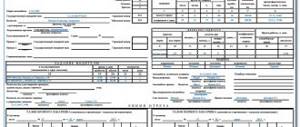- July 24, 2019
- Automobile law
- Daniil Belousov
Truck-type vehicles travel throughout the country, tirelessly delivering timber, coal, food and much more from point “A” to point “B”. As a rule, drivers have a hard time on the road. These are grueling trips, during which a transport company employee must not only keep an eye on the road, but also make sure not to provoke an emergency. The weight of the load is largely responsible for this. If it is exceeded, that is, the restrictions on the axis were not respected, then this can end in disaster.
Therefore, it is always important to comply with regulations. It’s not for nothing that axle loads in Russia are strictly regulated. If the carrier violates the requirements, then in this case he must be prepared to bear responsibility in the form of a fairly large fine. It will depend on the type of organization and several additional factors. Let's consider this topic in more detail.
general information
Many people do not quite understand what axle load means, and, moreover, exceeding this value. It's actually simple. In this case, we are talking about an overload of a truck, which puts increased pressure on the road surface. It should be borne in mind that the rear wheels (that is, one of the axles), as a rule, bear significantly more weight. This largely depends on the type of specific vehicle, its trailer and other parameters. But, despite everything, the rear axle exerts increased pressure.
To clarify the permissible weight of a road train in Russia, it is worth considering several important aspects. One of the very first is the type of truck. Based on their carrying capacity, it is easy to independently understand what kind of cargo will be acceptable in a given case.
Types of weight control
Weighing stations can be stationary or mobile.
Video - operation of a weight control point and fines for overloading a truck:
Stationary
are located in predetermined places; personnel and equipment are not moved to them.
Mobile
Weight control posts equipped on the basis of automobile vans are able to quickly change their location and turn into an unexpected surprise for truck owners.
Weight control is carried out in dynamic and static mode.
Dynamic
The measurement mode is carried out when the truck is moving at low speed using special sensors. Which sequentially take readings on each of the axes of the vehicle. The driving speed should not be more than 5 km/h. The disadvantage of this method is the significant, sometimes reaching 3% error in measurements.
Video - how weight control on the road should work:
Static
the method is more accurate. The measurement is taken with the car stationary. The method allows you to measure both the total weight of the vehicle and axle loads.
Types of vehicles
Most often on the road you can find semi-trailers that are suitable for most types of transported cargo. They are convenient because loading can be done from any side. Moreover, such trailers are capable of transporting up to 25 tons. Accordingly, the overload on the axes cannot in any way be higher (for detailed calculations, see below).
The second popular type is refrigerators. These are more expensive trailers that are full-fledged refrigeration units. They are necessary if the carrier needs to transport raw materials that may spoil. In the refrigerator, the temperature can be adjusted from +25 to -25 degrees, making it possible to deliver any type of product. Due to the rather voluminous refrigeration equipment, such trailers are not capable of transporting more than 20 tons.
A tanker is a trailer for small (mostly liquid) cargo. This type of transport vehicle is easy to load. Tanker trucks are capable of transporting from 15 to 25 tons of cargo.
You can also find so-called jumbos on the roads. These trailers are said to be capable of holding much more, which should make freight transport easier. This type of technology itself is distinguished by its L-shape. In this case, the trailer is equipped with small wheels, which are believed to be able to withstand heavy loads. However, such vehicles can rarely transport more than 20 tons.
There are also container ships, car transporters, dump trucks and many other varieties. All of them differ in their carrying capacity, which must be taken into account by the owner or employee of a company involved in the transportation of goods.
How is axle load calculated in Russia?
It’s worth noting right away that you can carry out such calculations yourself, but they may be inaccurate. Nevertheless, you can roughly estimate how much cargo a car can transport. To do this, you must first look at the registration certificate of the selected vehicle. It always indicates the weight parameters of the tractor itself, as well as its trailer.
After this, you need to determine the weight of the load. It must be indicated on the invoice. However, it must be remembered that errors may have appeared during its compilation or the calculations may have been made incorrectly. Therefore, those who transport freight need to be very careful. It's better to double-check everything several times.
If all the data is correct, then you can proceed to the next step. To find out the permissible axle load in Russia, you need to add up the weight of the trailer and the load itself. But this number is not yet final. It should be taken into account that the load will be distributed unevenly. As a rule, about 25% goes to the tractor itself, and the remainder - 75% - goes to the trailer. Therefore, you need to subtract 25% from the earlier number. The resulting 75% must be divided by the number of axles (depending on the type of car, this value may differ).
After this, it is necessary to clarify what load will fall on the axles of the tractor itself. There is already a value of 25% of the cargo mass, to which you need to add the weight of the truck itself. Thus, you can roughly calculate whether there will be overload on the axes or not. However, without knowing the allowed values, these parameters will not tell you anything. Therefore, it is worth getting a little more information.
Permissible load
Axial load is the load from the mass of the vehicle transmitted to the road surface by the wheels of one axle.
Roads during design and construction are calculated for a certain load.
Therefore, if the road load is set to no more than 10 tons per axle, exceeding the indicator will be a violation. This is due to the fact that with increased load the road surface deteriorates faster.
That is why in many settlements the movement of trucks is prohibited (that is, they cannot enter villages, etc.).
In most cases, the cargo bed (the heaviest part, the cargo) is located in the rear of the vehicle. The load on the axles may be uneven, but you should still strive to ensure that it is as uniform as possible.
What does this mean
Each truck has a permitted maximum axle load. This concept means the load from the total mass of the vehicle falling on the most loaded axle or bogie. This indicator is indicated on road signs that prohibit travel in certain areas.
But the maximum load and the permitted (permissible) load are two different things. Permitted means the load transmitted to the road surface by the wheels of one axle. This parameter is used during transport design.
Example: the PTS states that the weight of the vehicle is 9 tons, and the permissible maximum weight is 25 tons. This means that no more than 16 tons can be transported on a truck (25-9=16).
What are the regulations?
Heavy trucks are controlled on the basis of:
- Federal Law No. 257;
- Decrees of the Government of the Russian Federation No. 227;
- Fines for non-compliance with standards are imposed according to the Code of Administrative Offenses of the Russian Federation.
These acts establish:
- Maximum permissible axle loads for vehicles.
- Permissible overload.
- Rules for transporting goods exceeding the permitted norms.
- Permissible weights of trucks with or without trailers.
IMPORTANT! If the vehicle exceeds the permissible weight by more than 2%, then it is necessary to have a permit to travel. The exception is the transport of the Armed Forces of the Russian Federation. To obtain permission, the carrier is obliged to agree on the route of travel and compensate for the damage caused to the roadway.
The following permissible weight standards have been established for single trucks:
- two-axle: 18 t;
- three-axle: 25 t;
- four-axle: 32 t;
- 5 or more: 38 t.
For road trains:
- three-axle: 28 t;
- four-axle: 36 tons;
- five-axle: 40 t;
- 6 or more: 44 t.
To transport more than the established limit, you must obtain permission. It is issued for a period of up to three months.
Which cars does it apply to?
The standards apply to different types of trucks: road trains and single vehicles. A single truck is an indivisible vehicle without a trailer or semi-trailer (for example, a dump truck). A road train is two or more articulated vehicles (trailers, semi-trailers). Road trains are also divided into two categories: truck (tractor + semi-trailer) and trailed (truck + trailer(s)).
Who checks
The check is carried out by a traffic police inspector at special weight control posts: they can be mobile or stationary.
- Mobile. They are equipped on the basis of a cargo van and can change their location.
- Stationary. Marked with a “weight control” sign. As a rule, they are installed at the entrance or exit of populated areas.
If the weight of a truck with cargo is more than 80 tons, then the inspection draws up a special route, taking into account the admissibility of driving through special sections of the route and bridges (as well as other road structures). Overloaded vehicles are less easy to maneuver, so they pose an increased danger to both the driver and other road users.
How to correctly calculate the load
The load is calculated based on two parameters:
- by vehicle weight;
- by axle load.
The mass of the vehicle (curb or full) and the loads of its axle are related by the relation: Mts = Npo + Nzo, which means Vehicle mass = Load on the front axle + Load on the rear axle. This formula applies to a two-axle transport. For a three-axle there is another: Mts = Npo + Nzt (load on the rear bogie).
It will be more difficult to find out the load with the weight of the car, trailer and cargo. To do this, you need to follow the following algorithm:
- From the STS, take the vehicle weight and trailer weight. For example, let's take Ma = 6 t, Mn = 11 t.
- We find out the actual weight of the cargo. For example, 19 tons.
- The most common load ratio is: 0.75 for a trailer, 0.25 for a tractor. Then the load on the trailer: Np=0.75*(Mp+Mg)=22.5.
- The load in the trailer must be evenly distributed. Taking this into account, the load on one axle (No) is equal to Nn/number of axles = 22.5/3 = 7.5 t for each axle.
- Similarly, you can calculate the load on the axles of the machine. They account for the remaining 0.25 weight. That is (Mn+Mg)*0.25+Ma=(11+19)*0.25+6=13.5 t.
- The load on the rear axles of the car will be equal to 0.75 of the load on the truck. That is, 13.5*0.75/2=5.06.
- The load on the front axle is equal to what is left of the total load on the vehicle: in this case it turns out to be 3.37.
- It turns out that the approximate result of the weight distribution is: 3.37+5.06+5.06+7.5+7.5+7.5.
ATTENTION! Any calculation will be approximate and not exact.
Existing types of weight control
There are two types of weight control (that is, done in two ways):
- Dynamic. Vehicles move in a certain place, which is equipped with special sensors, at a speed of no more than 5 km/h. The measurement error using the dynamic method can be up to 3%;
- Static. Measurements are taken after the vehicle has come to a complete stop. This method determines the parameters more accurately.
How many tons per axle are allowed in Russia
Several years ago, the regulations were revised and revised requirements came into force. For example, according to official regulations, no additional permits will be required if the total weight of the vehicle with cargo does not exceed 44 tons. This is the maximum weight of the road train. It should not be exceeded. However, you need to understand that these standards have nothing to do with passenger cars.
If we talk about the permissible axle load in Russia, then this point should not be overlooked. It is better to always leave a few% reserve so that during the official inspection you do not encounter an unpleasant situation. Let's consider this topic in more detail.
Restrictions
There are a number of other requirements for road trains, tanks and other cargo vehicles that do not relate to weight. The rules concern the dimensions of heavy trucks, namely their length and width.
Acceptable values are specified in the traffic rules. In different states, the parameters may differ slightly from each other.
In Russia
In our country, the length of a road train should not exceed 20 meters. The maximum height is 4 meters from the road surface. If the equipment meets the parameters, movement on all roads of the Russian Federation occurs without restrictions and special permits.
In Europe
In the USA and Europe the requirements are stricter.
The length of a tractor with a semi-trailer must not exceed 16.5 meters. In addition, all heavy vehicles are subject to a toll for road use. Each driver or transport company is assigned a registration number, which, by entering it into the database, inspectors verify tax payment.
How to check a cargo vehicle
This procedure is called control weighing. In the process of simple manipulations, it is possible to find out whether the truck is overloaded. However, checkweighing cannot be done just anywhere. As a rule, these are special points on the highway where official inspectors check documents and compliance with regulations. There are two methods for such checks:
- Static.
- Dynamic.
Both methods of checking axle loads are acceptable and widely used in Russia. During static weighing, the car is placed on specialized scales. Thanks to this, it is possible to clarify the total mass. Dynamic testing involves the movement of the vehicle. Thanks to this, it is possible to clarify how much load falls on each individual axle. This test is considered the most accurate and relatively complex.
Permitted load abroad
It is important for merchants shipping cargo outside the Russian Federation to know what permitted loads on truck axles are provided in other countries. Violators face not only fines, but also the entry of the car number, as well as its owner, into the “black list”. The foreign traffic service is more systematized and has a common base of violators, so not a single car previously caught overweight will be able to pass the control point. The fines are high: given the exchange rate of the dollar and euro, plus the fee for transferring to another state, the fine may exceed the value of the cargo itself. Therefore, before taking risks, it is worth looking at Internet pages with statistics. Each country has its own acceptable standards.
- in Hungary, the potential load on a truck with two axles is 20 tons;
- in Germany – 18;
- in Bulgaria – 16.
There are clear tables with load distribution on all axles for European countries.
There are online calculators for calculating transport weight, but it is best to contact international logistics companies that know the intricacies of traveling on the road in a “foreign” country, will help in obtaining insurance, planning a route, and will advise on controversial issues.
Load sensors
Since 2021, cargo carriers have the opportunity to install special devices on their axles that help avoid errors that are often encountered during independent calculations. Thanks to the sensors, it is much easier to clarify whether the final value corresponds to the permissible axle weight in tons. As a rule, such controllers connect without any problems and allow you to evaluate not only the static value, but also the dynamic value, that is, when the car is in motion.
The controllers are universal, so they can be integrated into vehicles with any type of suspension and other characteristics. Small devices display all the necessary information on the dashboard. This allows the driver to always receive all the necessary information at any time while driving along the highway. In addition, the sensors also have a GPS module installed. Thanks to this, the operator can always control where the cargo is currently located.
Fines
If the permissible weight of cargo for a truck was exceeded, then the carrier bears some responsibility for such an offense. Therefore, it is worth familiarizing yourself with Administrative Code 12.21.1 in more detail. According to this document, there are several types of offenses.
For example, if the carrier violated the law and the overload on the axle was from 2% to 10%, and the driver was unable to provide special permission for such transportation, then in this case he will have to pay 1000-1500 rubles. At the same time, a fine will be imposed on the official who is responsible for the specific transportation. He will need to pay from 10 to 15 thousand rubles. If the excess axle load was recorded by an automatic recording device, then the owner of the truck must be paid at least 150,000 rubles.
In some situations, even having a special permit does not exempt you from liability. The amount of the fine may be reduced, but not by much. This is explained by the fact that such documents are often compiled with errors.
From 10% to 20%
If the carrier made such a big mistake and did not specify how many tons can be transported on Russian roads, then in this case he bears a great responsibility. In such a situation, the driver of such a truck will have to pay 3-4 thousand rubles. The person who was responsible for preparing the documents and allowed such a vehicle to set off will be subject to a fine of up to 30,000 rubles. A legal entity will have to pay at least 250 thousand rubles. If the offense was recorded automatically, then the minimum amount will be 300,000 rubles.
Responsibility
If the permitted weight of trucks on Russian roads is exceeded, the law provides for liability. And while motorists driving passenger cars may not worry about this issue, those driving large trucks need to think about it. The maximum permissible axle load is calculated before the moment the car leaves the assembly line.
Moreover, this point is always reflected in the vehicle documentation. A separate line is devoted to this topic, regulating such a process in the documents. Manufacturers calculate the permissible load levels of their equipment themselves.
And at the same time, the liability for violating this norm is quite serious. The thing is that overloading a car harms normal traffic. Overloaded transport provokes emergency situations. The movement becomes unstable. Loads additionally put pressure on the axles, which may one day not support the mass. Road surfaces are also destroyed due to the movement of overloaded vehicles on them. And at the same time, potholes on road surfaces are a pressing problem throughout Russia, and the presence of fines for overloading does not cover the damage that is caused to the road.
The components of vehicles become unusable much faster; overload leads to accelerated depreciation of the vehicle’s components. The chances that it will break soon increase significantly.
In addition, overloaded cars create additional risks on the roads. Overload lengthens the braking distance. And this is not a complete list of factors that can act as reasons for fines.
Larger loads
There are situations when the maximum permissible weight is exceeded by 20-50%. In this case, a fine of up to 5 thousand rubles is imposed on the driver himself. The official who signed the documents will have to pay at least 30,000 rubles. A legal entity is liable in the amount of 300-400 thousand rubles. If the violation is recorded by equipment, the fine can reach up to 400,000 “wooden”.
It will be most difficult for those who do not care at all about their financial situation and do not want to study the regulations. Rarely, but this still happens, the overload is more than 50%. In this case, the administrative fine will be the most severe. For the driver it will be at least 7,000 rubles. If he refuses to comply with the requirements, he may even lose his rights for six months. An employee who made a mistake in calculations will have to pay at least 45 thousand rubles. If we are talking about a legal entity, then this amount can be safely multiplied by 10. It will be most difficult if the offense was recorded by a recording device. In this situation, the fine will be at least half a million rubles.
If information about the weight of the cargo is deliberately distorted
It’s not enough just not to load the car too much. It is important that after weighing, all data matches the invoice. Accordingly, it should indicate the actual weight of the cargo, and not the one that is more convenient to enter in order to obtain the required permit.
If the documents contain incorrect information about the weight of the cargo, the duration and validity of the specialized permit, then you can pay in rubles. Also, offenses include situations when the consignment note does not contain a route drawn up for a specific cargo. All this will lead to penalties. Individuals will get off easy. They will have to pay 1500-2000 rubles. A little more responsibility falls on the official. A fine of up to 20 thousand rubles will be imposed on him. Of course, the legal entity will suffer the most. He will need to contribute at least 200,000 rubles to the state treasury.
Will there be a fine for overloading a passenger car axle?
Owners of this type of vehicle have nothing to worry about. The permissible values for loads and axles are exclusively for trucks. However, this does not mean that a “car” can be filled with any type of cargo and safely transported from one point to another. First of all, overload is dangerous for any vehicle. Under strong pressure, frames bend and shock absorbers stop functioning normally. The overall service life of the vehicle is significantly reduced.
Many people believe that when loading a car, they should be guided solely by their own ideas about overload and the capabilities of the car. At the same time, many drivers do not think at all about how passengers will feel. Some clog not only the luggage compartment of the vehicle, but also the interior, completely blocking the rear window. In this case, visibility will be impaired. If a motor vehicle accident occurs, then such a fact may be considered an aggravating factor.
A fine can be paid if the car accommodates more passengers than a particular car can carry. As a rule, including the driver, there can be no more than 4 people in a passenger car (three in the back seat and two people in front). All this information is indicated in the vehicle documents. Accordingly, if such a car is stopped by a traffic police officer, he can easily issue a fine.
It is noteworthy that many are confident that the child can be held in his arms, and then he will not have to be taken into account. In fact, children are the same passengers. Therefore, the child should have his own place. And if he is small, he must be transported in a special child seat with additional latches. All children under 12 years of age are required to ride in a car seat only. If it is missing, the driver will have to pay a fine. If the baby is even on the lap of the mother, who is placed in the back seat, this does not relieve the owner of the vehicle from responsibility. In such a situation, he will have to pay at least 3,000 rubles.
Yes, no one will weigh a passenger car. But if a traffic police officer determines other parameters in which the cargo clearly exceeds the permitted rules, then he can safely issue a fine. For example, if the car “sags”, the rear window is completely blocked, the vehicle even scratches the road surface with its bumper, or parts of the cargo move too far from the body, then all this may cause administrative liability.
In this case, a traffic police officer stops the vehicle, checks the driver’s documents and issues an appropriate fine. If a person cannot fully control a vehicle, then he becomes a dangerous road user. It could cause a serious accident. Therefore, not only its passengers are in danger, but also other road users. In such a situation, the minimum fine will be 500 rubles. If there are more people in the car than expected, then you will also have to bear responsibility. In such a situation, the driver will have to pay 500 rubles, and the “extra” passenger himself will have to pay 1000 rubles. According to the law, the fine can be general. For example, a traffic police officer can recover money only from a driver who allowed more people to travel in the car. In this case, he must pay a fine of 1,500 rubles.
About passenger cars
The Code of Administrative Offenses says nothing about overloading passenger cars. They are never subject to road weighing procedures. Fines for exceeding the permissible number of passengers in the cabin are provided due to the fact that such a circumstance makes the journey dangerous. This also affects the depreciation of the vehicle, greatly accelerating it. The car skids more often.
Therefore, inspectors issue fines for violating the rules for transporting passengers. It must be remembered that there must be as many passengers as indicated in the documentation.
For the first violation, a warning may be issued; for subsequent violations of the rules, the fine is five hundred rubles; for failure to fasten seat belts, the fine is already a thousand rubles.
Overloading a vehicle is considered a dangerous violation, for this reason it entails liability. Before starting the journey, you must familiarize yourself with the rules. If in some cases responsibility is assigned to the transport organizations that organized the transportation, then ordinary motorists need to bear responsibility personally.










